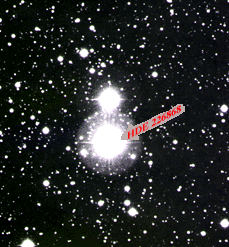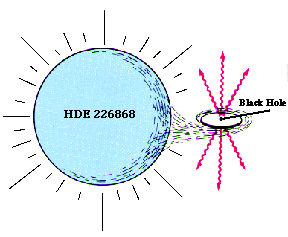Saturday, October 18, 2008
Black holes
NOTE: This section is about what are called "stellar-mass black holes". For information about black holes with the mass of billions of Suns, see Active Galaxies & Quasars .
Black Holes: What Are They?
Black holes are the evolutionary endpoints of stars at least 10 to 15 times as massive as the Sun. If a star that massive or larger undergoes a supernova explosion, it may leave behind a fairly massive burned out stellar remnant. With no outward forces to oppose gravitational forces, the remnant will collapse in on itself. The star eventually collapses to the point of zero volume and infinite density, creating what is known as a " singularity ". As the density increases, the path of light rays emitted from the star are bent and eventually wrapped irrevocably around the star. Any emitted photons are trapped into an orbit by the intense gravitational field; they will never leave it. Because no light escapes after the star reaches this infinite density, it is called a black hole.But contrary to popular myth, a black hole is not a cosmic vacuum cleaner. If our Sun was suddenly replaced with a black hole of the same mass, the earth's orbit around the Sun would be unchanged. (Of course the Earth's temperature would change, and there would be no solar wind or solar magnetic storms affecting us.) To be "sucked" into a black hole, one has to cross inside the Schwarzschild radius. At this radius, the escape speed is equal to the speed of light, and once light passes through, even it cannot escape.
The Schwarzschild radius can be calculated using the equation for escape speed.
If We Can't See Them, How Do We Know They're There?

Since black holes are small (only a few to a few tens of kilometers in size), and light that would allow us to see them cannot escape, a black hole floating alone in space would be hard, if not impossible, to see. For instance, the photograph above shows the optical companion star to the (invisible) black hole candidate Cyg X-1.
However, if a black hole passes through a cloud of interstellar matter, or is close to another "normal" star, the black hole can accrete matter into itself. As the matter falls or is pulled towards the black hole, it gains kinetic energy, heats up and is squeezed by tidal forces. The heating ionizes the atoms, and when the atoms reach a few million degrees Kelvin, they emit X-rays. The X-rays are sent off into space before the matter crosses the Schwarzschild radius and crashes into the singularity. Thus we can see this X-ray emission.
Binary X-ray sources are also places to find strong black hole candidates. A companion star is a perfect source of infalling material for a black hole. A binary system also allows the calculation of the black hole candidate's mass. Once the mass is found, it can be determined if the candidate is a neutron star or a black hole, since neutron stars always have masses of about 1.5 times the mass of the sun. Another sign of the presence of a black hole is random variation of emitted X-rays. The infalling matter that emits X-rays does not fall into the black hole at a steady rate, but rather more sporadically, which causes an observable variation in X-ray intensity. Additionally, if the X-ray source is in a binary system, the X-rays will be periodically cut off as the source is eclipsed by the companion star. When looking for black hole candidates, all these things are taken into account. Many X-ray satellites have scanned the skies for X-ray sources that might be possible black hole candidates.
Cygnus X-1 is the longest known of the black hole candidates. It is a highly variable and irregular source with X-ray emission that flickers in hundredths of a second. An object cannot flicker faster than the time required for light to travel across the object. In a hundredth of a second, light travels 3000 kilometers. This is one fourth of Earth's diameter! So the region emitting the x-rays around Cygnus X-1 is rather small. Its companion star, HDE 226868 is a B0 supergiant with a surface temperature of about 31,000 K. Spectroscopic observations show that the spectral lines of HDE 226868 shift back and forth with a period of 5.6 days. From the mass-luminosity relation, the mass of this supergiant is calculated as 30 times the mass of the Sun. Cyg X-1 must have a mass of about 7 solar masses or else it would not exert enough gravitational pull to cause the wobble in the spectral lines of HDE 226868. Since 7 solar masses is too large to be a white dwarf or neutron star, it must be a black hole.

However, there are arguments against Cyg X-1 being a black hole. HDE 226868 might be undermassive for its spectral type, which would make Cyg X-1 less massive than previously calculated. In addition, uncertainties in the distance to the binary system would also influence mass calculations. All of these uncertainties can make a case for Cyg X-1 having only 3 solar masses, thus allowing for the possibility that it is a neutron star.
Nonetheless, there are now about 10 binaries for which the evidence for a black hole is much stronger than in Cygnus X-1. The first of these, an X-ray transient called A0620-00, was discovered in 1975, and the mass of the compact object was determined in the mid-1980's to be greater than 3.5 solar masses. This very clearly excludes a neutron star, which has a mass near 1.5 solar masses, even allowing for all known theoretical uncertainties. The best case for a black hole is probably V404 Cygni, whose compact star is at least 10 solar masses. With improved instrumentation, the pace of discovery has accelerated over the last five years or so, and the list of dynamically confirmed black hole binaries is growing rapidly.





No comments:
Post a Comment